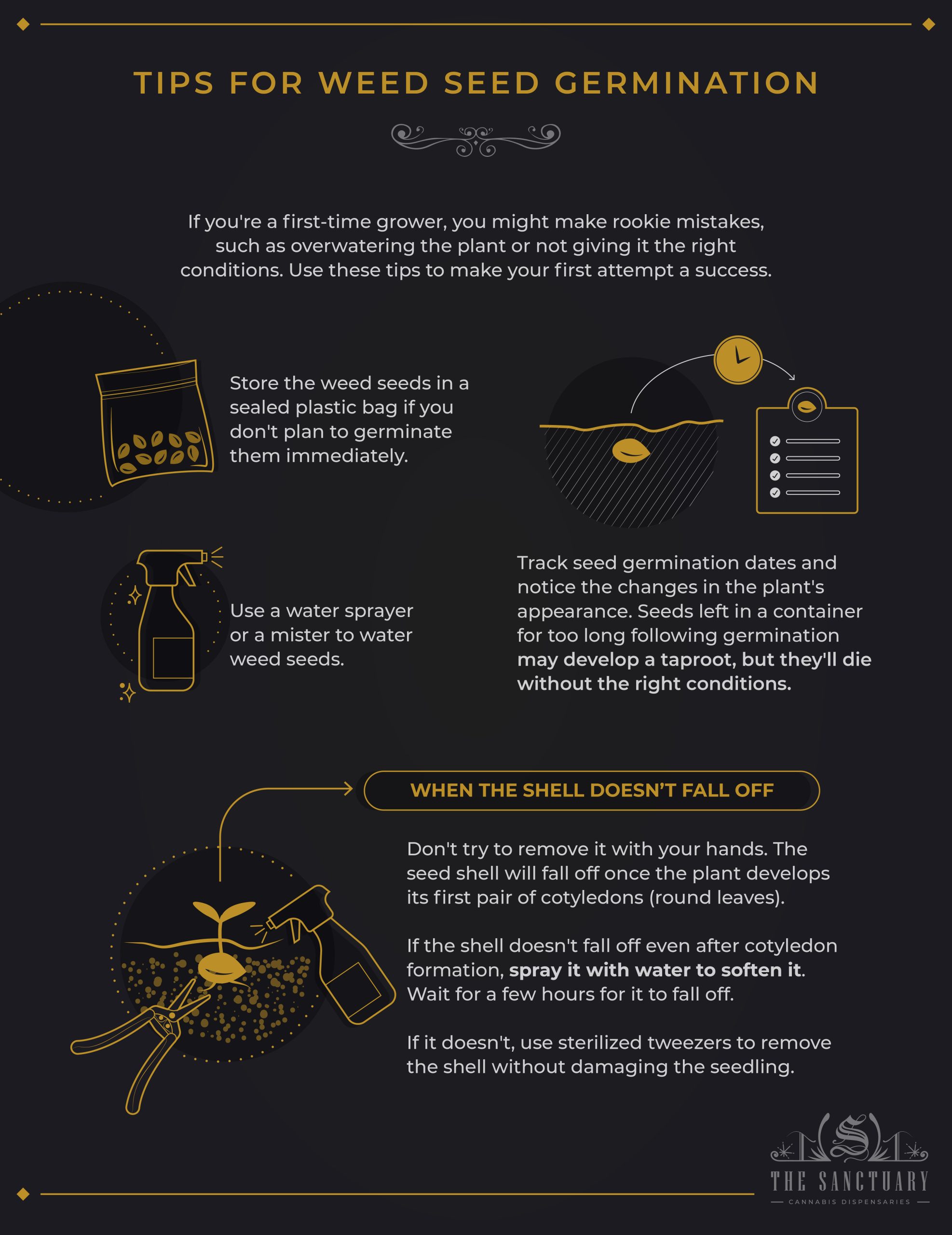Iftikhar Alam
Author
Reviewed by Cannabis Experts
Published on: May 17, 2023 | Updated on: September 11, 2024
Like any other plant, cannabis also has various growing stages, ranging from germination and seedling stage to vegetative, sexual maturity, and flowering stages. But germination is where it all begins as the seed sprouts.
The germination period for weed seeds is anywhere from 3 to 10 days. In some cases, seeds may germinate in as little as 24 hours, while in others, they may take up to two weeks.
Regardless of the germination period, you should know a few things about weed seed germination, such as the right time, method, and temperature. Let’s learn more about these factors.
How to Choose the Right Cannabis Seeds?
In most, if not all, cases, the seeds do germinate. But that doesn’t always mean they will produce a strong plant. As this weak plant grows, it will not do well in the vegetative and flowering stages.
That’s why you should look for dark-colored seeds since they are more likely to germinate. Meanwhile, white or pale green seeds will either not germinate or produce a weak plant.
Even if you see minor signs of damage on dark-colored seeds, you’re still good to go. Sometimes, the outer shell is slightly crushed, but the dark-colored seed still grows into a healthy plant.
Optimal Conditions For Weed Seed Germination
Besides selecting the right seeds, it’s also essential to give this seed optimal conditions for germination.
Temperature
Temperature plays a vital role in seed germination since it influences hormone function, enzyme activity, and plant moisture content. Warm temperatures help speed up chemical reactions in the seed, resulting in quicker cell formation.
However, if the temperature is too high, it might suppress the plant’s growth. The ideal temperature for weed seed germination is 22° to 25°C (71–77°F).
Growing Environment
Ideally, the growing environment for weed seeds should be moist but not completely wet. A damp environment is best suited for this plant. The humidity levels should be between 70% and 90%.
Lighting
Lighting also forms the growing environment for any plant. Weed seedlings prefer fluorescent lighting, such as CFL bulbs with a blue spectrum for the initial 10 to 14 days. The 18/6 light cycle (18 hours of light and 6 hours of darkness) is ideal for weed seeds.
Once the seed germinates and develops at least two or three nodes along with true leaves, move the plant to an LED or HID light.
pH Value
The pH refers to the acidity or alkalinity of the soil. It affects plant enzyme activity since enzymes only work in an optimal pH range. For weed seeds, this range is 5.8–6.2, which is slightly acidic.
Germination Methods For Weed Seeds
The method you select will also somewhat affect the germination time for weed seeds. Here are some common methods.
Glass of Water
If you don’t want to go through a lot of hassle, a glass of water is all you need to germinate weed seeds. While this method is not always effective, it’s viable.
Here’s how to do it:
- Fill half a glass of water at 22°C (71°F).
- Wait for 3 to 5 days to see the seeds opening. When the seeds open, you will see tiny white tips sprouting from them.
- Transfer the seed with roots from water to pre-prepared soil when the roots reach 3 cm in length.
To prepare the pot, fill it with soil that’s been moistened with water. Make 10–15mm deep small holes in the pot for aeration. Then, plant the seeds in this soil and keep the pot under fluorescent lighting, at least 5 to 6 inches away from the light source.
Weed seeds do not need a lot of water in the early stages. Instead of using a can, water the growing plant with a mister to prevent overwatering.
Wet Kitchen Towel
A more effective and commonly used method is the wet kitchen towel method. The process has quite a few variations. For instance, you can use absorbent paper or cotton wool pads instead of a damp kitchen towel.
But since kitchen towels are readily available in most homes, they’re your go-to for weed seed germination. Here’s how to perfect this method:
- Take a sheet of kitchen towel and put it on a flat surface.
- Dampen it with a spray bottle.
- Place the weed seeds on the kitchen towel, spacing them a few centimeters apart.
- Put another kitchen towel to cover the seeds, dampen it and press it gently.
- Check the seed progress daily by removing the kitchen towel’s top layer.
- Once white root tips get 3 cm long, move the seeds from the paper towel to the plant pot.
Tips for Weed Seed Germination

If you’re a first-time grower, you might make rookie mistakes, such as overwatering the plant or not giving it the right conditions. Use these tips to make your first attempt a success.
- Store the weed seeds in a sealed plastic bag if you don’t plan to germinate them immediately.
- Use a water sprayer or a mister to water weed seeds.
- Track seed germination dates and notice the changes in the plant’s appearance. Seeds left in a container, such as a paper towel, for too long following germination may develop a taproot, but they’ll die without the right conditions.
- If the seed has sprouted, but the seed shell is still stuck on it, don’t try to remove it with your hands. The seed shell will fall off once the plant develops its first pair of cotyledons (round leaves).
- If the shell is too hard and doesn’t fall off even after cotyledon formation, spray it with water to soften it. Wait for a few hours for it to fall off. If it doesn’t, use sterilized tweezers to remove the shell without damaging the seedling.
Conclusion
On average, the seed weed germination period is between three days and two weeks. Depending on the growing conditions, germination method, and seed strain, the seeds may germinate sooner or later.
As soon as the seed germinates and develops root tips of significant length, transfer it to a pot with suitable soil and environmental conditions.
The content provided on this blog is for informational purposes only and does not constitute medical, legal, or professional advice. Cannabis use is subject to local laws and regulations, which vary widely by jurisdiction. Always consult with a healthcare professional before starting any new treatment or altering an existing treatment regimen. The authors and publishers of this blog are not responsible for any actions taken based on the information provided herein. Use cannabis responsibly and in accordance with applicable laws. This blog is intended for adults aged 21 and over. The Sanctuary Dispensaries D186, D187.








